Tony LePrieur photographed this American Dipper at Elbow Falls, west of Bragg Creek, in November 2017. This is a reliable place to see dippers.


Tony LePrieur photographed this American Dipper at Elbow Falls, west of Bragg Creek, in November 2017. This is a reliable place to see dippers.


Posted by Bob Lefebvre
The Wild Bird Store is one of the few places in Calgary where you can buy good quality bird seed, feeders, and houses, and the only store that specializes in products for birders. Recently they have moved to a new location, and this Saturday, October 21, they will have an all-day 20th anniversary and grand re-opening event at their new location, 5901-3 Street SE (on 58 Avenue, three blocks west of Blackfoot Trail).
Besides the savings for backyard birders, there will be several interesting presentations throughout the day that should interest all local birders: Chris Fisher’s All-Star Critters, Myrna Pearman on Bird Feeding Behavior, and Gus Yaki on Attracting Birds to Your Backyard. At the end, Gus will also do a presentation on the ten-day walk he led this spring from the Saskatchewan border to Writing-On-Stone Provincial park.

The Calgary Wildlife Rehabilitation Society will also be there (with live birds of prey), as will the Alberta Institute for Wildlife Conservation. So there will be plenty going on to interest birders of all ages!
The new Wild Bird Store is located at 5901-3 Street SE.

Tony LePrieur took these great photos of a huge Brown-headed Cowbird fledgling being fed by its foster parent, a male Yellow Warbler.

Brown-headed Cowbird being fed by a Yellow Warbler, Calgary, July 8, 2017. Photo by Tony LePrieur.

The warbler is off to find more food for its demanding foster child.
Brown-headed Cowbirds lay their eggs in other birds’ nests and often the other species does not recognize the difference and raises the young cowbird. For more photos of cowbirds with some other host species see these posts:
Posted by Bob Lefebvre
In this recent post about local bird nest cameras, I mentioned that the camera at the Peregrine Falcon nest at the University of Calgary was no longer available online, and that most of the historical data was no longer available either. I have been told by the Media Relations department at the U of C that the decision to remove support was not a budget issue (as I stated), but a resource one. Libraries and Cultural Resources at the U of C are now working with Alberta Conservation Association and Biological Sciences (UCalgary) to partner and take over the project.
The good news is that the historical data about the Peregrines nesting at the U of C has been permanently archived and is available online at this link. We will have a link on our right-hand sidebar under “Calgary Nest Cameras” also.
The bad news is that the Peregrines did not return to nest at the U of C this year. The nest camera continues to be monitored by U of C staff, and if they return the camera link will be restored. (This page would have a link to the camera feed if it was live.) But since the birds are usually back here by the end of March, if they are not here yet, they are not coming. Either something happened to one of the adults, or they are nesting elsewhere.
If you know of any Peregrine Falcons nesting in Calgary, either at the Foothills Hospital, Downtown, or elsewhere, please leave a comment.
Posted by Bob Lefebvre
Brown Thrashers are rather late migrants, usually arriving in the Calgary area in mid-May or even late May, as do their Gray Catbird cousins. The bird shown here was one that actually overwintered here this year. It was first noticed before Christmas 2016 in Airdrie by Heinrich Lohmann.
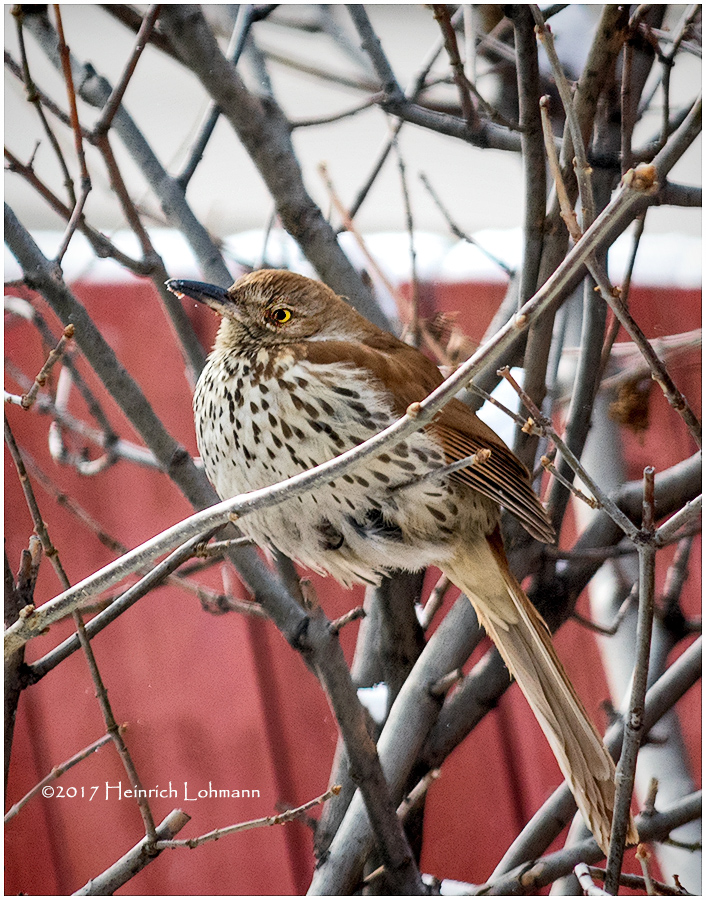
Brown Thrasher, Airdrie, January 16, 2017. Photo by Heinrich Lohmann.
The bird was coming to a feeder in Heinrich’s yard and continued to do so into March of this year. The photo below was taken on March 10th, and the bird was last seen on March 11th. It may have moved on to its summer territory then, getting a big jump on its migratory rivals (although if so, it will have a bit of wait for any females to arrive back).
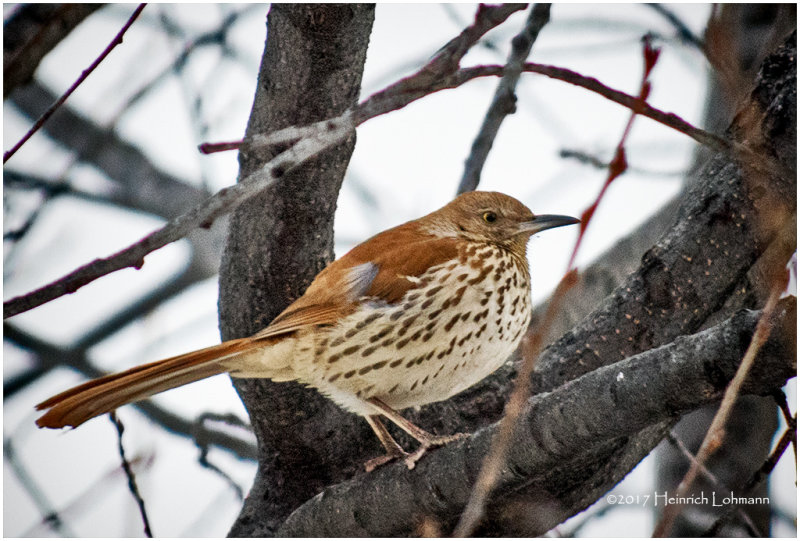
Brown Thrasher, Airdrie, March 10, 2017. Photo by Heinrich Lohmann.
It’s not unheard-of for Brown Thrashers to overwinter in Alberta. One was seen in Calgary in December 2015 and (I believe) one in Canmore later that winter. One was seen north of Edmonton in February 2015. Of course, these birds are at high risk when spending the winter so far north. Their normal winter range is in the SE United States. As I said, a bird that successfully overwinters here will get first choice of breeding territories. But it’s also possible that birds that overwinter are only doing so because they were sick or injured during the migration period, and were unable to head south.
In any case it’s always interesting to see a “summer” bird here in mid-winter.
Posted by Bob Lefebvre
It’s always fun during breeding season to watch live video of nesting birds from nest cameras around the world. There are some local ones that we provide links to each spring. The links given below are always also visible on our right-hand sidebar.
Calgary Zoo Osprey Nest Cam: This camera has been operating for many years. This year, the nest platform and camera were moved a bit downstream from its usual location, but the Ospreys are back and refurbishing the nest right now.

An April 18th still from the nest camera. From the Twitter feed of boooneill (@ koniell57).
Gray Jay Nest at Ellis Bird Farm: This was the first ever live view of a Gray Jay nest, so this one, operated by the Ellis Bird Farm north of Red Deer, attracted a lot of attention. Unfortunately the nest recently failed. There are still some videos at the link. If the birds re-nest this year and it can be located, new video may be available. The nest was located about 100 km north of Calgary. Information about this and other cameras operated by the Ellis Bird Farm can be found on their website here.
___________________________________________________________
Please note the following correction to the three italicized paragraphs below, about the Peregrine Falcons at the University of Calgary (added May 10, 2017):
According to Drew Scherban, the Acting Manager of Media Relations for the U of C, the removal of the web pages was a resources issue, not a budget one. Libraries and Cultural Resources are now working with Alberta Conservation Association and Biological Sciences (UCalgary) to partner and take over the project. The historical observations of the Peregrine Falcons have been permanently archived and are available on this page, which we will also link to on our right-hand sidebar.
Unfortunately, there is not a live stream of the nest site right now, because the falcons did not return this year. Staff will continue to monitor the camera feed and if the birds appear they will put it up on this page.
Since the birds usually arrive back here in late March or early April, I think it’s safe to say they will not be returning to the U of C this year. One or more of the adults may have died, or they have found another spot to nest.
___________________________________________________________
Here are the original three paragraphs at the end of this post:
Normally we have a link to the popular University of Calgary Peregrine Falcon nest camera, but this year, the camera is no longer online. In addition, the recent pages with all of the observations from 2010 on have been removed. All that is left online are the historical observations from 1995-2009, so we have a link to that.
I have tried to find out more about this, but haven’t heard back from anyone about who operated the camera or if the link will ever be restored. But the web page was maintained through the U of C’s library and and cultural resources, and they have decided to remove that support as part of their 2017-2018 budget cuts.
The university prides itself on its community outreach, so it’s a shame that they decided to cut this. Perhaps if they got feedback from people who valued the project they would reconsider; if not this year, then next. You can contact the Community Engagement Team on this page, or Thomas Hickerson, Vice-Provost (Libraries) here.
Please leave a comment here if you have any information about this camera or any others in the Calgary area. In 2016 there was a nesting box installed at the top of the Foothills Hospital in the hopes of attracting more Peregrines, but again, I haven’t been able to find out if there is a nest camera or website this year, or if any birds are nesting there.
Tony LePrieur photographed these two male Mountain Bluebirds having a bit of a tussle near Priddis, SW of Calgary, on April 8.

Mountain Bluebirds (males), near Priddis, April 8, 2017. Photo by Tony LePrieur.
The birds may have been battling over a good territory. Many bluebirds are back in the area now, but some of the females have not yet returned. Primarily an insect-eater, Mountain Bluebirds can get into real trouble when we get heavy snowfalls (like we’re having tonight), especially if it stays cold for an extended period. They will also eat berries.

One bluebird gets the upper hand!

The victorious male. Both birds were OK, but only one gets the territory.
Posted by Bob Lefebvre
The spectacular crow-sized Pileated Woodpecker is always a treat to see, and they are not very shy birds, so occasionally you can get great close-up looks at them. They are not common in Calgary. Look for them in three areas: Around the Glenmore Reservoir, including the Weaselhead, and upstream on the Elbow River through Griffith Woods Park; The west end of Fish Creek Park; The east end of Fish Creek Park on the Bow River, and north on the river as far as Carburn Park. They are year-round residents here, so look for them any time you are out in these parks. If you live near these areas you may also get them coming to suet or nut feeders occasionally.
All photos by Tony LePrieur.

Pileated Woodpecker (male), Bebo Grove, Fish Creek Park, December 4, 2016.
In the above photo you can see the distinctive rectangular hole that these birds make when feeding. They eat Carpenter Ants, which often infest large trees and deadfall. If you see a fresh hole like this, often near the base of a large tree, you will know you are in a Pileated Woodpecker’s territory.

Female Pileated Woodpecker, Bebo Grove, Fish Creek Park, December 4, 2016.
The female above (likely the mate of the male in the first photo) is distinguished from the male by the black stripe from the bill to the throat, which is red in males. In addition, the red crest does not extend all the way to the front of the head on the female as it does on the male.
The nest hole of a Pileated Woodpecker is a large oval, usually high in a dead tree, or occasionally in a power pole (as seen in Griffith Woods Park). The male will make a new nest hole each year.
Below are more of Tony’s photos of Pileated Woodpeckers in Calgary.

Pileated Woodpecker (female), Fish Creek Park, January 31, 2016.
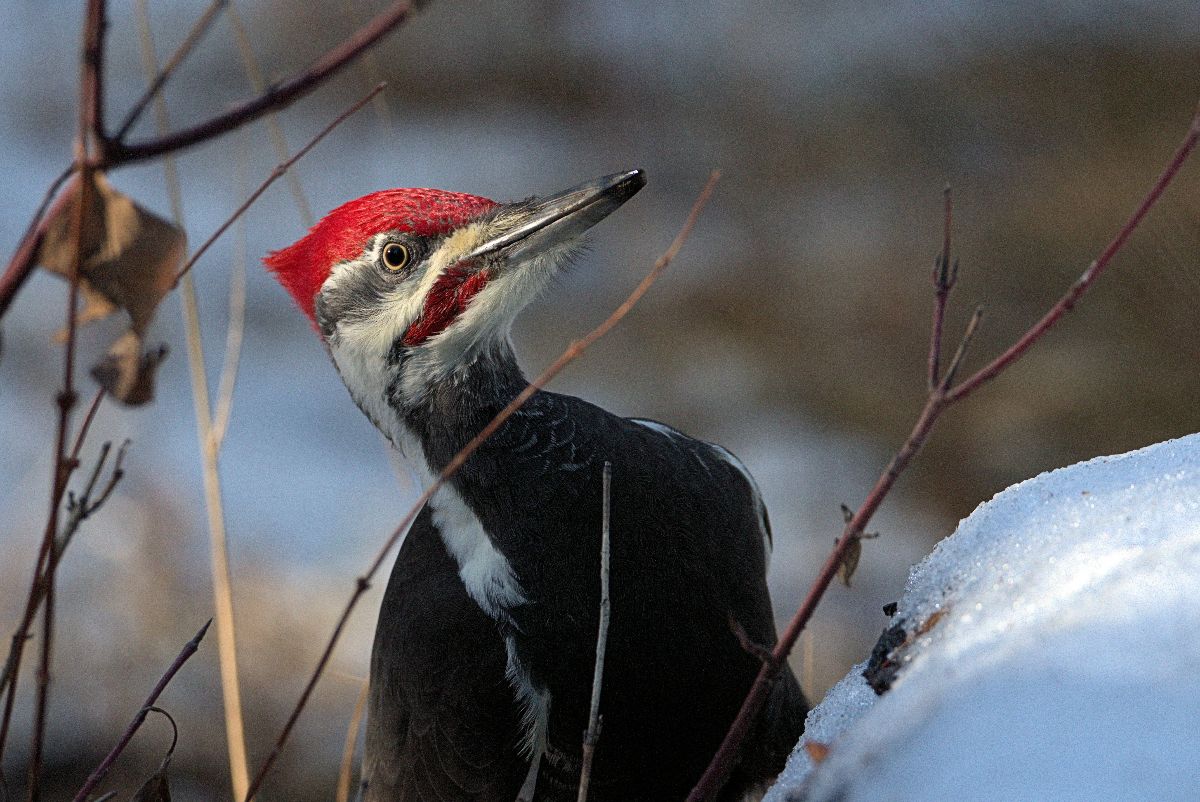
Pileated Woodpecker (male), Fish Creek Park, November 26, 2015.
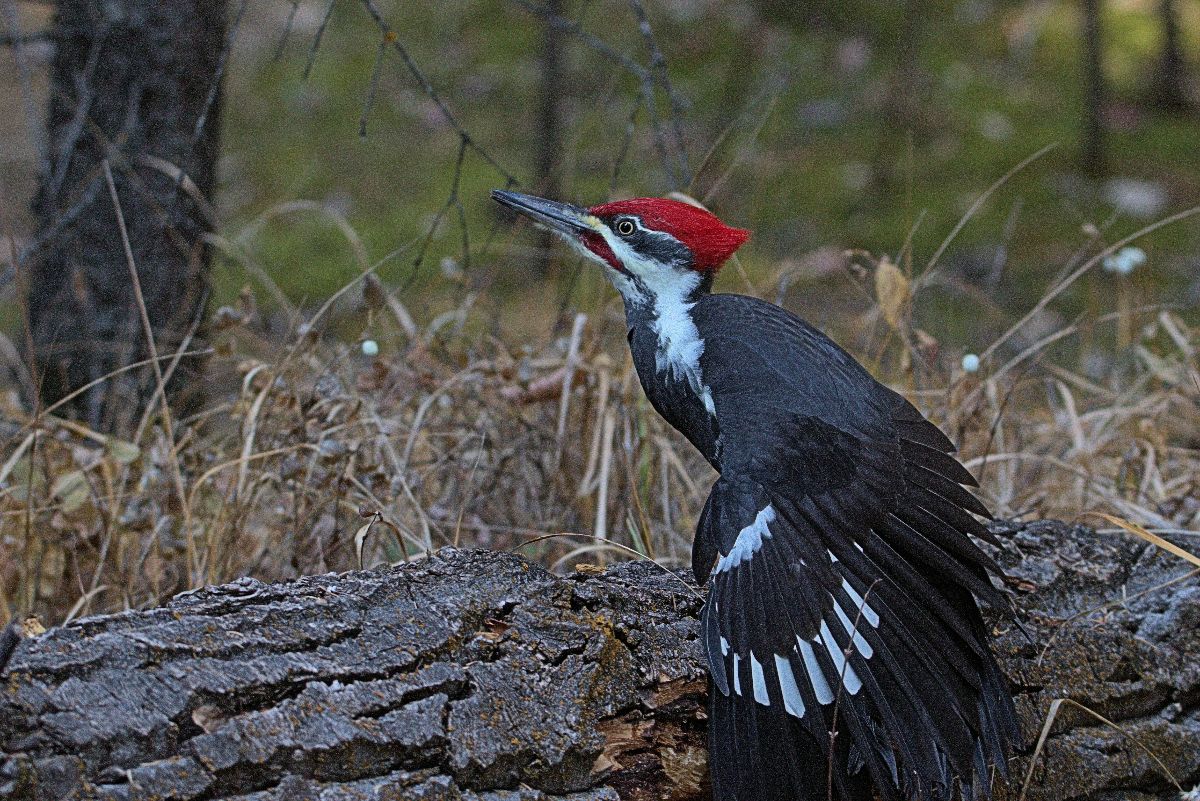
Pileated Woodpecker (male), Fish Creek Park, October 25, 2015.
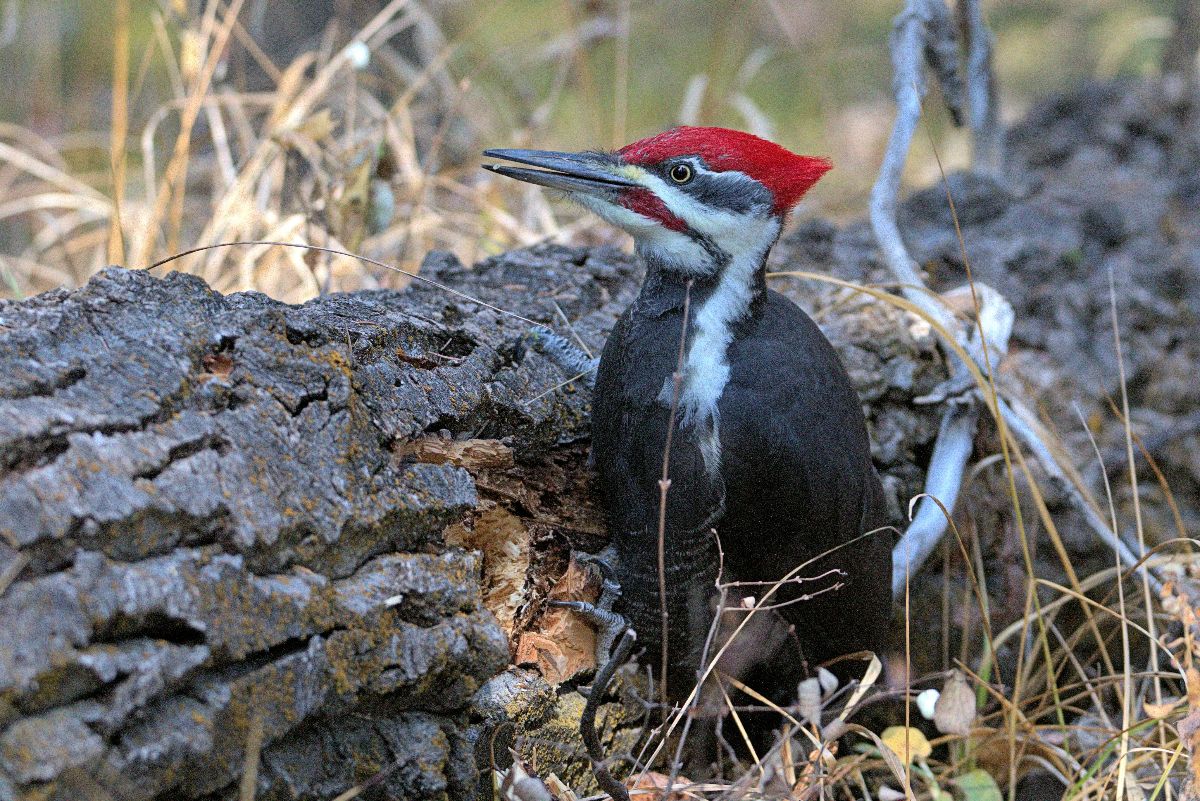
Pileated Woodpecker (male), Fish Creek Park, October 25, 2015.
For more photos of Pileated Woodpeckers see these posts.
You can see more of Tony LePrieur’s photos on his Flickr Page here.
Posted by Bob Lefebvre
Brown-headed Cowbirds are obligate nest parasites, so they do not nest or raise their own young – the female cowbird lays her eggs in a number of nests of other species. If the host birds don’t realize that they are incubating a foreign egg, they will feed the cowbird chick until it fledges and for a while afterwards, until it can forage on its own and rejoin its cowbird cousins.
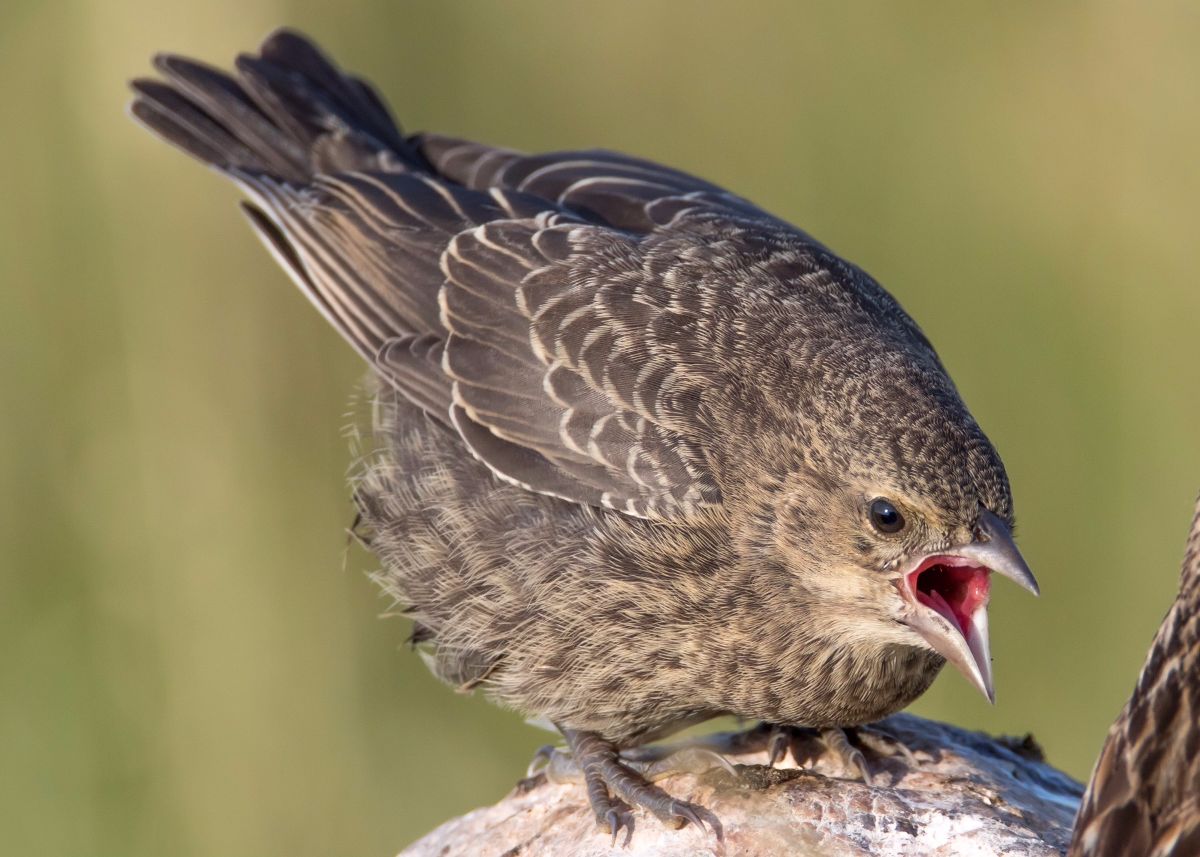
Brown-headed Cowbird chick, just out of the nest and begging for food. (All photos taken by Tony LePrieur, July 1, 2016.)
Many of the songbirds that are parasitized in this way are quite a bit smaller than cowbirds, so it makes for a comical sight when the “parents” are feeding their giant “offspring”. It’s no joke for the host parents, though, as this is a great drain on their food-gathering resources, and it has a negative impact on their ability to raise their own biological young.
Tony LePrieur has recently seen a number of young cowbirds being fed by different hosts in the Calgary area. Thanks to Tony for these fantastic photos!

Song Sparrow (left) feeding a Brown-headed Cowbird chick. Sikome Lake, Fish Creek Provincial Park.

Calling for food from the host Song Sparrow.

Another cowbird being fed by a Western Wood-Pewee, not far from the Song Sparrow and chick at Sikome, Fish Creek Park. This could very well be a biological sibling of the bird being fed by the Song Sparrow.

The Western Wood-Pewee adult, probably a little worn out from trying to provide for the cowbird chick.

Two cowbirds were being fed by a pair of Savannah Sparrows at Frank Lake, also on Canada Day.

A close-up taken from the above photo.

Those of you with teen-aged boys will know how this Savannah Sparrow feels 🙁
Cowbirds also often parasitize Clay-colored Sparrows and even smaller birds like Yellow Warblers and House Wrens, so if you see any of those species carrying food, watch to see if they are feeding cowbirds.
Do you have photos of birds taken in the Calgary area? Send them to us and we may post them on the blog! birdscalgary@gmail.com
Posted by Bob Lefebvre. Photos copyright by themorningsideoflife.ca.
An avid birdlover in Calgary has set up a nest box camera in her yard, affording great views of a pair of Red-breasted Nuthatches that are trying to nest there. I say “trying” because after they brought in loads of nesting material, a pair of Black-capped Chickadees, working together very quickly, moved in and cleaned it all out again. Then the nuthatches recaptured the box and are bringing in more grass and wood shavings to line their nest. (The chickadees settled into a different nest box in the yard.)

One of the Nuthatches in the nest box, no doubt keeping a watch for Chickadees.
The nest box can be watched live on Ustream at this link. There are also many saved video clips that you can play to see what has happened up to now. The live camera is not always online, but it usually is during the daytime, and when it’s on you can comment on what you see using your Facebook or Twitter account. The nuthatches are most active at the nest from 6 to 10 am.

The female nuthatch, named Lucy, at the nest box.
It will be extremely interesting to watch if they they do successfully have young. The vocalizations and behaviors recorded up to now are fascinating to see and hear. It’s a view of Red-breasted Nuthatches that we don’t usually get!

The male nuthatch, named Ricky (of course), ready to drive off chickadees.
The camera link will be on on our right-hand sidebar throughout the nesting season, along with the Osprey and Peregrine Falcon camera links. The camera link can also be found at the camera owner’s blog, The Morning Side Of Life. Check it out for great bird photos. You can also find a link to her blog on our sidebar with the other blog links.
You might want to also check out a new Facebook group called Alberta Backyard Birds (& Feeder Watch) for more photos and discussion of yard birds.